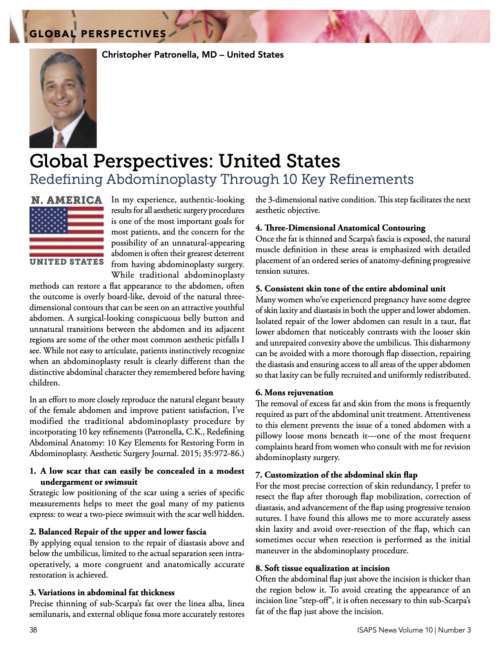"Redefining Abdominoplasty Through 10 Key Refinements"
 This article was originally published in ISAPS News, September – December 2016
This article was originally published in ISAPS News, September – December 2016
Patronella, C.K., Redefining Abdominoplasty Through 10 Key Elements. ISAPS News. Volume 10, Number 3, September – December 2016
In my experience, authentic-looking results for all aesthetic surgery procedures is one of the most important goals for most patients, and the concern for the possibility of an unnatural-appearing abdomen is often their greatest deterrent from having abdominoplasty surgery.
While traditional abdominoplasty methods can restore a flat appearance to the abdomen, often the outcome is overly board-like, devoid of the natural three-dimensional contours that can be seen on an attractive youthful abdomen. A surgical-looking conspicuous belly button and unnatural transitions between the abdomen and its adjacent regions are some of the other most common aesthetic pitfalls I see. While not easy to articulate, patients instinctively recognize when an abdominoplasty result is clearly different than the distinctive abdominal character they remembered before having children.
In an effort to more closely reproduce the natural elegant beauty of the female abdomen and improve patient satisfaction, I’ve modified the traditional abdominoplasty procedure by incorporating 10 key refinements (Patronella, C.K., Redefining Abdominal Anatomy: 10 Key Elements for Restoring Form in Abdominoplasty. Aesthetic Surgery Journal. 2015; 35:972-86.)
1. A low scar that can easily be concealed in a modest undergarment or swimsuit
Strategic low positioning of the scar using a series of specific measurements helps to meet the goal many of my patients express: to wear a two-piece swimsuit with the scar well hidden.
2. Balanced Repair of the upper and lower fascia
By applying equal tension to the repair of diastasis above and below the umbilicus, limited to the actual separation seen intra-operatively, a more congruent and anatomically accurate restoration is achieved.
3. Variations in abdominal fat thickness
Precise thinning of sub-Scarpa’s fat over the linea alba, linea semilunaris, and external oblique fossa more accurately restores the 3-dimensional native condition. This step facilitates the next aesthetic objective.
4. Three-Dimensional Anatomical Contouring
Once the fat is thinned and Scarpa’s fascia is exposed, the natural muscle definition in these areas is emphasized with detailed placement of an ordered series of anatomy-defining progressive tension sutures.
5. Consistent skin tone of the entire abdominal unit
Many women who’ve experienced pregnancy have some degree of skin laxity and diastasis in both the upper and lower abdomen. Isolated repair of the lower abdomen can result in a taut, flat lower abdomen that noticeably contrasts with the looser skin and unrepaired convexity above the umbilicus. This disharmony can be avoided with a more thorough flap dissection, repairing the diastasis and ensuring access to all areas of the upper abdomen so that laxity can be fully recruited and uniformly redistributed.
6. Mons rejuvenation
The removal of excess fat and skin from the mons is frequently required as part of the abdominal unit treatment. Attentiveness to this element prevents the issue of a toned abdomen with a pillowy loose mons beneath it—one of the most frequent complaints heard from women who consult with me for revision abdominoplasty surgery.
7. Customization of the abdominal skin flap
For the most precise correction of skin redundancy, I prefer to resect the flap after thorough flap mobilization, correction of diastasis and advancement of the flap using progressive tension sutures. I have found this allows me to more accurately assess skin laxity and avoid over-resection of the flap, which can sometimes occur when resection is performed as the initial maneuver in the abdominoplasty procedure.
8. Soft tissue equalization at incision
Often the abdominal flap just above the incision is thicker than the region below it. To avoid creating the appearance of an incision line “step-off”, it is often necessary to thin sub-Scarpa’s fat of the flap just above the incision.
9. Comprehensive torso unit treatment
Attentive treatment of the entire torso, particularly the hips and waist, creates a more harmonious overall aesthetic outcome. As plastic surgeons, we should use our vision and experience to assist our patients in understanding the potential impact of treating the entire aesthetic unit. I frequently combine abdominoplasty with liposuction of the waist, hips and thighs; and body lift surgery to achieve a more toned, smoother transition to the lateral portion of the abdomen/hip/buttock aesthetic unit.
10. Restoration of a deeply-contoured navel
Small though it is, the umbilicus is a key distinguishing factor of a natural versus surgical-looking abdominoplasty outcome. Though opinions vary on the ideal umbilical contour, I opt for a vertically-oriented, deep oval shape.
Fat removal in a vertical fashion where the umbilicus is to be repositioned restores the native condition, and four small dermal flaps allow the umbilical inset site to be pulled downward toward the umbilical base.
ABDOMINOPLASTY
As my 25-year career in plastic surgery has progressed, I’ve observed that my patients have become more informed and far more detail-oriented in their aesthetic goals. Through online research and more openness among consumers in social circles, they’ve typically viewed numerous results directly or through before and after photos on blogs and websites. In addition, patient reviews and candid comments help them identify and express what they do and do not want. It seems clear that consumer demand for better, more natural looking results will continue to spur plastic surgeons to develop and refine techniques that accomplish their patients’ objectives, advancing the art and science of plastic surgery in the process.


